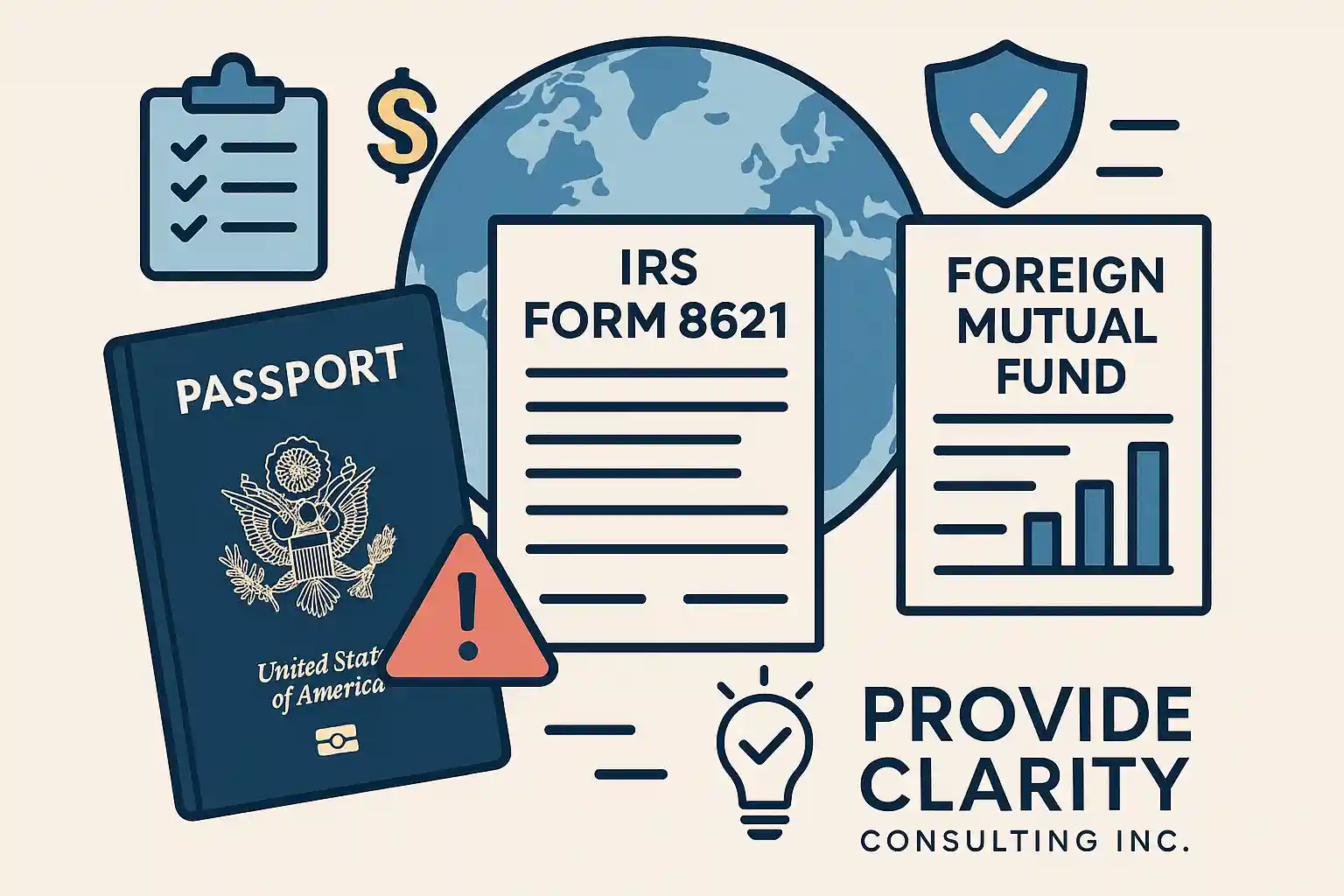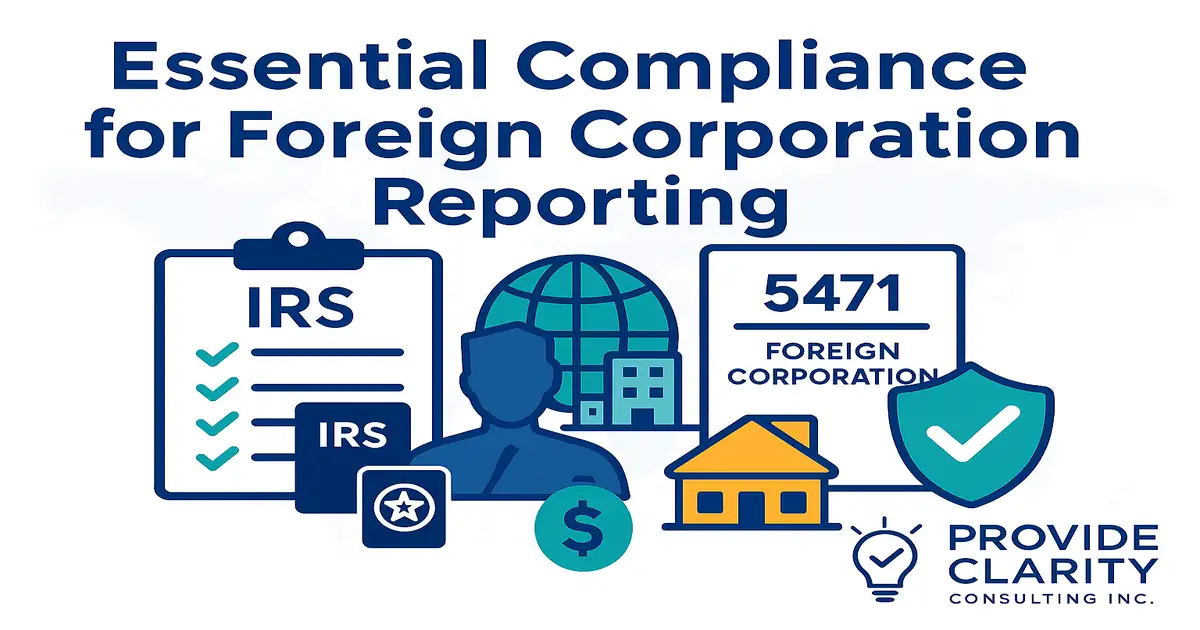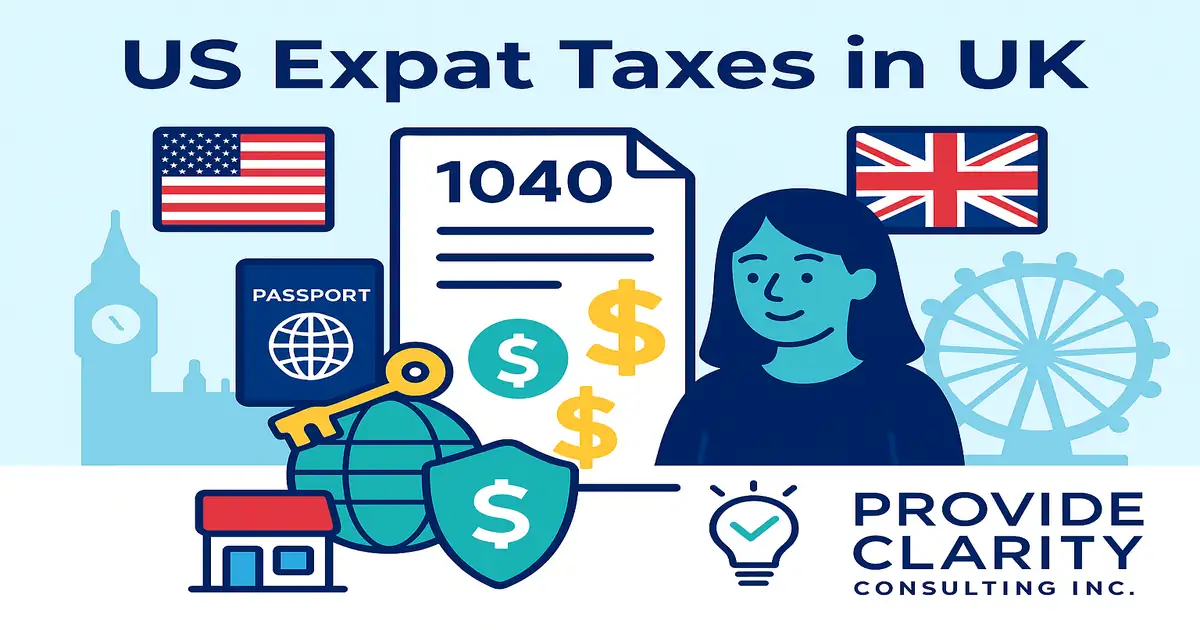Understanding PFICs and IRS Form 8621: Essential Guide for US Expats and International Investors
Estimated reading time: 15 minutes
This guide provides essential insights into PFIC to help you navigate compliance effectively.
Key takeaways:
- PFICs can result in complex tax implications for US expats and international investors.
- Form 8621 is crucial for compliance and avoiding IRS penalties.
- There are different taxation methods for PFICs, each with pros and cons.
- Professional tax guidance can save time and prevent costly mistakes.
- Non-compliance can lead to severe financial consequences.
Table of Contents
- Introduction: PFICs and Form 8621. What Every US Expat and International Investor Needs to Know
- What is a PFIC?
- Why PFICs Matter: US Tax Implications for Expat and International Investors
- Form 8621 – The IRS’s Way to Keep Track
- How are PFICs Taxed? The Three Taxation Methods Explained
- Penalties and Risks: Why Compliance with Form 8621 is Crucial
- Practical PFIC Survival Guide: Tips for US Expats and International Investors
- Common Pitfalls: What to Avoid with PFICs
- Real-World Scenarios
- Frequently Asked Questions (FAQs)
- How We Help: Our Cross-Border Tax Expertise
- Call to Action — Don’t Risk Costly Mistakes: Consult a PFIC and US Expat Tax Expert Today
Introduction: PFICs and Form 8621. What Every US Expat and International Investor Needs to Know
If you’re a US expat or an American investor with assets overseas, chances are you’ve heard the term PFIC or Passive Foreign Investment Company. But what exactly is a PFIC, and why is the IRS so laser-focused on these investments? Perhaps most importantly: what’s up with Form 8621, and what are the risks if you ignore it? Whether you own a foreign mutual fund, ETF, or another passive foreign holding, understanding your reporting obligations is crucial to navigating the world of US expat taxes and foreign mutual fund reporting.
In this comprehensive guide, we break down the PFIC rules, the tax headaches they bring, why compliance is essential, and practical advice to keep you penalty-free while positioning our firm as your trusted guide in the global tax landscape.
What is a PFIC?
PFIC is short for Passive Foreign Investment Company. Under IRS rules, a foreign corporation qualifies as a PFIC if it meets either of these criteria in a tax year:
- At least 75% of its gross income is considered passive (income from sources like interest, dividends, rents, royalties, or capital gains),
or
- At least 50% of its assets (measured by value or basis) produce or are held to produce passive income.
Common Examples of PFICs
- Foreign Mutual Funds: The quintessential PFIC! If you’ve invested in a non-US mutual fund, it’s almost definitely a PFIC.
- Foreign ETFs (Exchange-Traded Funds): Many non-US ETFs also meet PFIC criteria.
- Some Foreign Hedge Funds, Money Market Accounts, and Investment Trusts: Especially those that aren't structured as US mutual funds.
- Certain Foreign Corporations: That generate primarily passive income.
Why are these treated so harshly? The IRS knows PFICs allow US taxpayers to access potentially tax-deferred foreign earnings, something Congress wanted to prevent!
Why PFICs Matter: US Tax Implications for Expat and International Investors
The US tax system, unlike many others, taxes its citizens (and resident aliens) on worldwide income, including earnings from PFICs, even if you live abroad full year.
PFICs present three major tax headaches:
- Unfavorable Tax Rates: Gains and distributions often get taxed at ordinary income rates, not reduced capital gains.
- Excess Taxation with Interest Charges: The IRS may treat years of untaxed earnings as if you took a massive windfall today, adding interest for each year the income was “deferred.”
- Complex Reporting: Form 8621, in all its glory, looms over your annual return.
In short: Owning a PFIC means more complex expat tax filings, potentially punitive taxes, and a real risk of IRS scrutiny if you get it wrong.
Form 8621 – The IRS’s Way to Keep Track
IRS Form 8621 (Information Return by a Shareholder of a Passive Foreign Investment Company or Qualified Electing Fund) is your portal for reporting direct and indirect ownership of PFICs (even if you didn’t take any distributions!).
You must file Form 8621 for each PFIC you hold. Sometimes, this means attaching multiple versions of the form to a single tax return, an administrative headache, but a crucial compliance step.
You’re required to file Form 8621 for each tax year you:
- Receive income or gains from a PFIC.
- Make certain elections (see below),
- Or, in many cases, simply hold a PFIC (even with no actual distributions).
Source: IRS - Understanding Form 8621 Requirements
How are PFICs Taxed? The Three Taxation Methods Explained
PFICs have three possible US tax treatments. By default, the IRS will assume the “Excess Distribution” method unless you make a specific election.
Let’s examine each option, complete with straightforward examples for US expats and international investors.
1. The Default: Excess Distribution (Sec. 1291) Method
How it works:
- “Excess distributions” and any gains realized on sale/redemption are allocated pro rata over the period you’ve held the PFIC.
- These allocations (except for the current year) are taxed at the highest ordinary income tax rate plus accrued interest as if you paid late.
What’s an excess distribution?
Any payouts in a year that are more than 125% of the average distributions in the three prior years.
Simple Example:
- You held a foreign mutual fund (a PFIC) for five years.
- This year, you sell it for a $10,000 gain.
- That $10,000 is distributed over your five-year holding period. All prior years’ amounts are taxed at top rates plus compound interest as if you underpaid your taxes.
Takeaway:
The excess distribution method usually leads to very significant tax and interest charges—often much higher than simply investing in a comparable US mutual fund.
Resource for more detail: PFIC Taxation Examples - IRS Instructions
2. Qualified Electing Fund (QEF) Election
How it works:
- You make a QEF election if the PFIC provides annual financial information (not common, but possible for large or investor-friendly funds).
- Each year, you’re taxed on your share of the PFIC’s ordinary income and capital gains—whether or not you receive any actual cash.
Simple Example:
Your foreign ETF makes $2,500 of income in a year (but distributes nothing).
Because you elected QEF, you report and pay tax on $2,500 of income that year, at ordinary and capital gains rates as appropriate.
Pros:
- No punitive interest charges or top-rate double taxation.
- Income is reported each year, like a US mutual fund.
Cons:
Requires cooperation from the PFIC to provide detailed annual information, which is rare except for certain familiar funds.
Full details: IRS QEF Election Explanation
3. Mark-to-Market (MTM) Election
How it works:
- Permitted for marketable PFICs (like many foreign mutual funds/ETFs publicly traded on a recognized exchange).
- At year-end, you pretend you sold all PFIC shares for fair market value.
- Recognize any gain as ordinary income (not capital gain!). Losses can be recognized in certain situations.
Simple Example:
You purchase a foreign ETF for $20,000. End of year, its value is $21,000.
On your US tax return, you report $1,000 of ordinary income, even if you haven’t sold it.
If next year it drops to $20,500, you can claim a $500 loss (subject to certain limitations).
Pros:
- No excess distributions or historical interest charges.
- More predictable year-to-year taxation.
Cons:
- Gains are always ordinary income—never favorable long-term capital gains.
- Losses aren’t always fully deductible.
More info: Mark-to-Market PFIC Rules - IRS Resource
Penalties and Risks: Why Compliance with Form 8621 is Crucial
Ignoring PFIC rules doesn’t make them go away. Non-compliance just multiplies the risks:
- Failure to File Penalties: While Form 8621 doesn’t currently have an automatic monetary penalty attached, failing to file can freeze the statute of limitations on your entire tax return, meaning the IRS could potentially audit your taxes indefinitely until you file the missing form(s)!
- Increased Tax Bills: As shown above, if you’re forced into the Excess Distribution method after years of ignoring PFIC reporting, tax and interest can easily add up to massive bills, even exceeding your original gain.
- Loss of Elections: You may permanently lose the chance to benefit from QEF or MTM treatment if you don’t make timely, correct elections.
- Indirect FBAR/FATCA Penalties: Unreported PFICs often result in botched FBAR and FATCA filings, both with draconian penalties.
- Compounding Complexity: Later amendments to prior year returns can get expensive and trigger audit risks.
Source: IRS PFIC Penalties and Compliance
Practical PFIC Survival Guide: Tips for US Expats and International Investors
How can taxpayers avoid the most common PFIC pitfalls? Our experience as cross-border tax consultants highlights the steps to take:
1. Stay Vigilant About Your Investments
- Assume any non-US pooled investment (mutual fund, ETF) may be a PFIC unless proven otherwise.
- Check your portfolio regularly. Foreign banks often recommend their in-house fund products without warning US citizens of PFIC issues.
2. Get Professional Help Early
- The simplest and most effective step is to consult a cross-border tax advisor who can identify PFICs, make timely elections, ensure accurate Form 8621 filing, and minimize your tax bite.
- Don’t wait until a sale or distribution structure investments for tax efficiency up front.
3. Maintain Meticulous Records
- Retain purchase/sale confirmations and annual statements for all foreign holdings.
- Ask funds up front if they can supply QEF annual information (a rarity, but worth a shot!).
4. Keep on Top of Deadlines
- Form 8621 must be filed annually with your US tax return, not just in years you sell or receive distributions.
- Set reminders or work with a professional to avoid late or omitted forms.
5. Diversify Using US-Based Investments (Where Possible)
- For many expats, using US-domiciled funds or ETFs sidesteps the PFIC trap entirely.
- Consider “look-through” structures with careful legal and tax planning if foreign investments are necessary.
6. Educate Yourself
- Read the IRS instructions for Form 8621 and stay abreast of updates.
Common Pitfalls: What to Avoid with PFICs
- Choosing foreign mutual funds without being unaware of PFIC consequences.
- Ignoring indirect PFIC exposure: For example, investing in a foreign pension plan or insurance wrapper that owns PFICs inside.
- Late or missed Form 8621 filings: This risks open audits and loss of key tax elections.
- Misunderstanding “marketable” status for MTM election: Not every foreign fund qualifies.
Real-World Scenarios
Scenario 1: The Unwitting Expat Investor
Sarah, an American working in the UK, invests her savings in a popular local mutual fund recommended by her bank. She doesn’t realize it’s a PFIC until several years later. When she moves home, a US accountant reviews her portfolio, identifies the PFIC, and advises a “mark-to-market” election. This proactive step, though generating some annual tax, prevents ruinous excess distribution taxation and years of compounded interest. Lesson: Early detection and intervention can save thousands.
Scenario 2: The DIY Investor Facing Penalties
Miguel, a US citizen living in Mexico, manages his investments and holds several foreign ETFs. He ignores the complexity of US tax filings, failing to file Form 8621. Several years later, the IRS asks for clarification, and Miguel must amend five years’ worth of returns, opening himself up to possible audits and interest-based tax penalties. Lesson: Non-compliance can turn a tax oversight into a major financial and administrative nightmare.
Scenario 3: Proactive Planning with QEF
Louise, a high-net-worth individual, invests in a specialized offshore fund that provides QEF statements. Her US tax advisor makes the QEF election in year one. Louise reports her share of fund income every year, avoiding excess distribution and interest issues, and benefits from more favorable capital gains rates. Lesson: Sometimes, communicating with foreign fund managers pays off.
Frequently Asked Questions (FAQs)
Q: Do I have to file Form 8621 if I didn’t sell my PFIC or receive distributions?
Q: Can I avoid PFIC taxation by holding the foreign fund in a foreign retirement plan?
Q: Is there any “safe” amount of PFIC holdings under which I don’t need to file?
Q: Can I amend prior years to make PFIC elections (QEF or MTM) retroactively?
Q: Are there US-based alternatives to foreign funds for expats?
How We Help: Our Cross-Border Tax Expertise
Navigating PFIC rules and filing Form 8621 is a classic example of where specialized, hands-on tax guidance pays enormous dividends.
As a US and international tax consulting firm, we offer:
- Upfront PFIC exposure reviews (before you invest or when you relocate).
- Strategic election advice (QEF, MTM, or best alternatives).
- A team familiar with the quirks of foreign fund documentation and IRS requirements.
- Defense and correction of past non-compliance, minimizing penalties and tax owed.
We view ourselves as your financial “lifeguard”, helping you steer clear of the tax undertow so you can swim in global markets with confidence.
Don’t Risk Costly Mistakes: Consult a PFIC and US Expat Tax Expert Today
PFICs and Form 8621 trip up even the savviest investors. The sooner you review your holdings and address compliance, the better your results—and your peace of mind.
Ready to take the guesswork out of global investing? Contact our cross-border tax specialists today! We’ll help you
- Identify PFICs in your portfolio.
- Make the smartest tax elections.
- Stay compliant with all IRS reporting requirements.
- And keep more of your hard-earned money where it belongs, with you.
You can also schedule a complimentary strategy session or check out our in-depth guides on FBAR compliance and Foreign Earned Income Exclusion (FEIE) to complete your international tax toolkit!
References and Resources:
Your global investments are only as strong as your tax compliance. Let us help you build that foundation—today.




